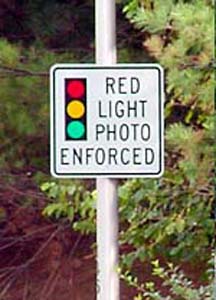![[Metroactive Features]](http://metroactive.com/features/gifs/feat468.gif)
[ Features Index | Silicon Valley | Metroactive Home | Archives ]

Rev Surveillance Though this can be frustrating for paranoid people like me—I mean, what's next, tickets for jaywalking using facial-recognition patterns to identify us?—technology goes both ways By Novella Carpenter BILL IS in the doghouse. Today's mail included a ticket with a photo of our car's license plate. I asked him about it, and he said, "Let's talk about that later"—which is code for never. Turned out he tried to go through a toll bridge using his friend's toll-paying device. My question is, How did the machine know the toll-paying device was on the wrong car? I have a feeling the machines are getting smarter and smarter these days. For instance, consider the so-called red-light cameras. According to the geeky How Stuff Works website, red-light cameras work by using induction loop triggers. There are cameras mounted on the traffic lights with a computer connected to the cameras. Down below, under the asphalt, are thin loops of electrical wire. When a car drives through the electromagnetic field generated by the loops, something called inductance levels increases. The computer recognizes a shift in the levels, causing the computer to tell the cameras to take a photo. In most areas, the red-light cameras take two photos: one frontal to get a shot of the driver's face, and one behind to get the license plate. Not all red-light cameras work on this principle—some use lasers, others use something called a video loop. The computer reads a video feed from the intersection and can "recognize" a car speeding through a red light. Either way, the computer notes the date and time of the incident, and the police send out a bill. The cameras are on 24 hours a day and generate a tidy revenue. Though this can be frustrating for paranoid people like me—I mean, what's next, tickets for jaywalking using facial-recognition patterns to identify us?—technology goes both ways. When we think of surveillance, we might imagine a faceless body taking in data that will later be used against us. But we can make the machines work for us, too. Take, for example, the phenomena of "regional messaging": that is, highway signs smart enough to warn drivers of congestion or disasters that might lie ahead. In Florida, the Department of Transportation has come up with a network of highway surveillance cameras and a uniform coding system that warns drivers of congestion or accidents. According to the Palm Beach Post, this traffic-management system has reduced delays by 30 percent in the last two years. The idea is to warn drivers early enough so that they can take a different route. In California, similar "thinking" signs will give estimates on travel times to areas along the highway. I pulled over once because of a sign warning of a one-hour delay and took a nap. But why bother getting into our cars when we can use webcams and other tools that let us monitor traffic real-time from our cushy desks and sofas? All over the country, more and more state agencies are erecting their very own traffic webcams. Some are better than others. My favorite traffic webcams are in New York City. The city has set up the Advanced Traveler Information System that allows drivers to choose from video feeds from a variety of cameras located in the Big Apple. At 1am, the cabs clog the streets; a mist of pollution (?) blows across the screen; the neon lights fling themselves everywhere. If I squint, I can pretend I'm looking out the window of my tiny apartment on the Lower East Side. In California and Arizona, there's www.sigalert.com. This cool site doesn't use bandwidth-gouging images but gives average speed estimates. During nontraffic times, there will be plenty of 70s and 80s, but congestion will be signaled by 20 and 30 mph listings. Sigalert also covers traffic accidents. On a hot map, it will show places where accidents occurred and, often, details like "Traffic collision—debris/objects" or "traffic hazards—vehicle" with the cross streets of the accident. Suddenly, when we are the ones doing the monitoring, it seems all right.
Send a letter to the editor about this story to letters@metronews.com. [ Silicon Valley | Metroactive Home | Archives ]
|
From the February 8-14, 2006 issue of Metro, Silicon Valley's Weekly Newspaper.
Copyright © 2006 Metro Publishing Inc. Metroactive is affiliated with the Boulevards Network.
For more information about the San Jose/Silicon Valley area, visit sanjose.com.